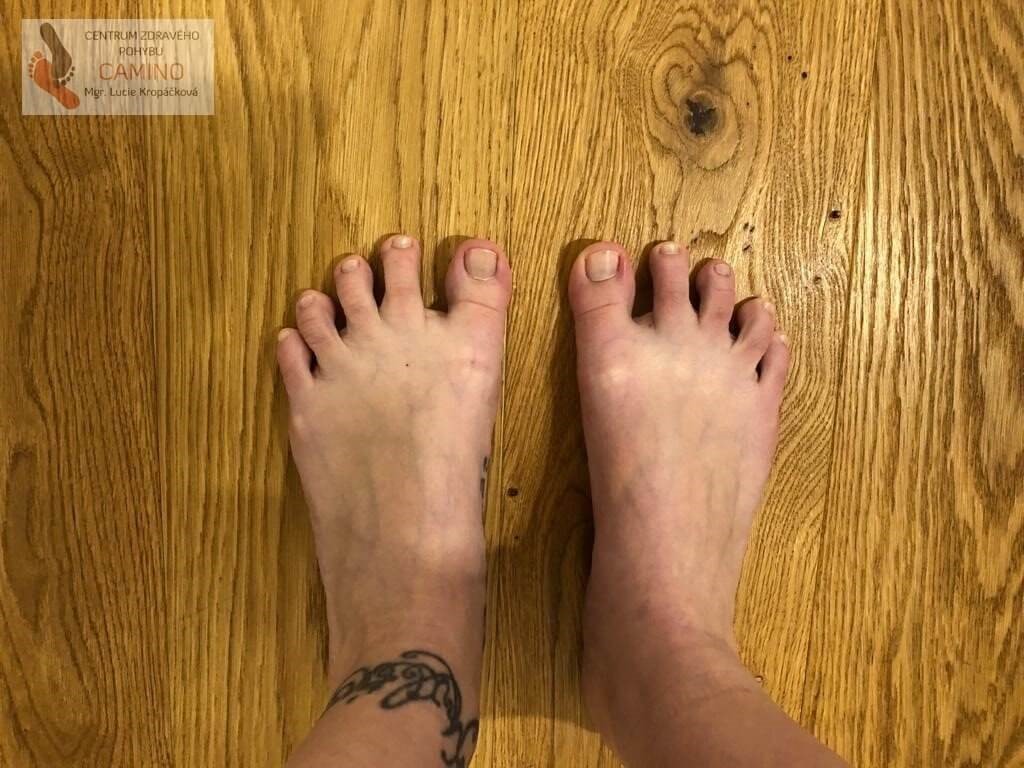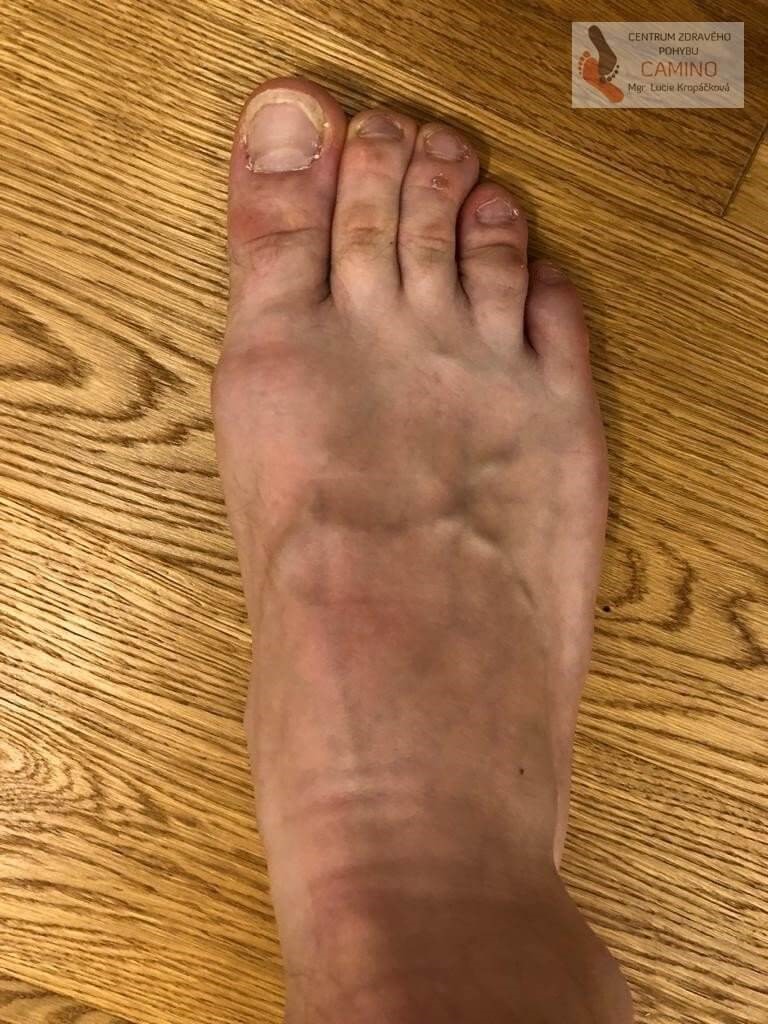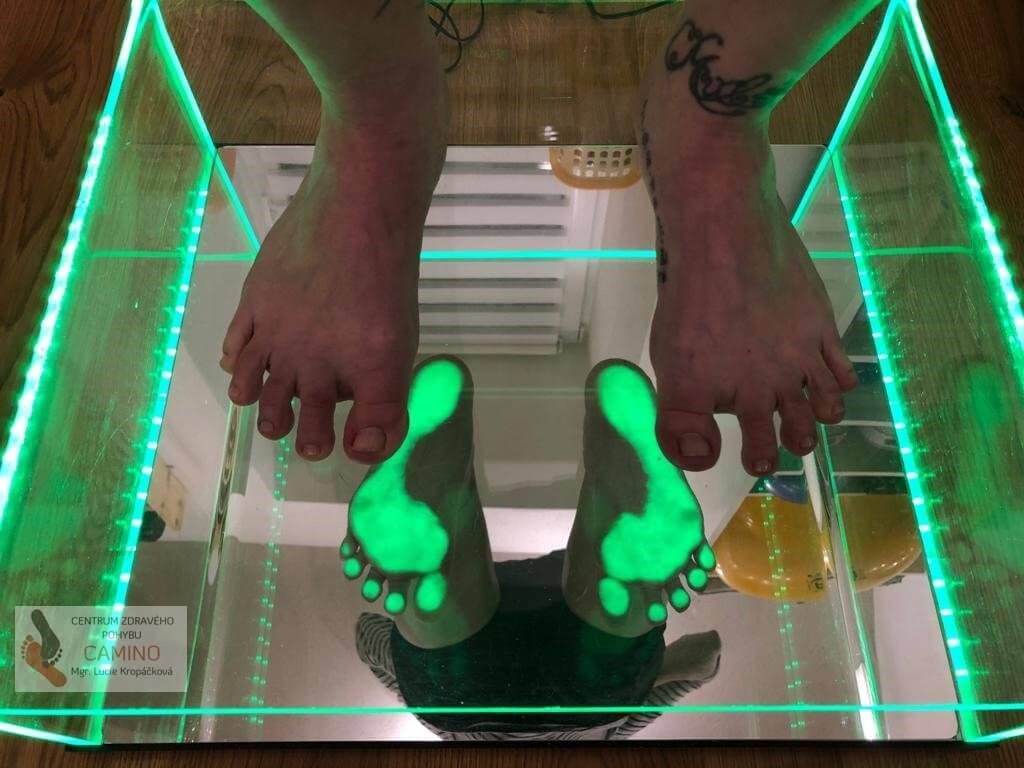The foot is a unique tool for moving on two limbs, and is unique to humans. Feet are now in the forefront of attention with more and more people interested in healthy footwear. What is really healthy for our feet and how do we meet their needs?
NATURAL DEFECTS ARE NOT COMMON
The vast majority of us are born with healthy feet, congenital foot defects appear in only 3 percent of cases (3). However, studies show that a third of first-graders (4, 5) start school with an acquired leg defect. If we look at the data from studies from Czech schools, at the second stage of primary school it is almost half of the children (3, 6). The results indicate that during the early years of life, we do something detrimental to our feet, or the feet of our children. How does it happen that flat feet, a bent toe, or maybe hammer toes appear? What effects can these acquired leg defects have on other parts of the body?
The development of the specific human gait began 2 to 3 million years ago (1). Our ancestors evolved in motion over a long period time, often moving from place to place for various reasons. They did not settle until the end of the last ice age, ie. 6000 years ago. Even then, however, movement did not disappear from their lives. The phenomenon of a sedentary lifestyle has only emerged over the last 100 years and is now typical for contemporary society (2). As natural movement in our population decreases, there is a growing need to ensure we get enough healthy movement, also shedding light on the importance of healthy footwear.

PHOTO - Try to separate your toes as much as possible. Can you do it? No? And what if I tell you that any child under the age of 6 can handle this challenge without any problems. That means you could do it before. Don't give up, thorough training can make your body remember and re-learn spreading your toes correctly again. © CZP Camino, L. Kropáčková
IS IT OUR FAULT?
The condition of our body depends on several factors. First, there are genetic predispositions and innate anatomical conditions. They contribute about one third to the final state of our body (2). The remaining two thirds, which contribute more significantly are caused by the conditions of our environment and surroundings. Everything we do, the way we move and how we behave, reflects back on our body in the form of structural changes. Our feet are a perfect example. Due to the cramped space and restricted contact with the terrain by our modern shoes, the functions of the foot first "fall asleep" and may even disappear over time. The foot responds to this whole process by changing its structure, which affects its shape and function.

PHOTO - Shoe-shaped foot deformed by prolonged wearing of a conventional shoe that does not respect the shape of the foot. © CZP Camino, L. Kropáčková
BAREFOOT BUT IN A SHOE
Unlike other parts of the body, the foot contains a huge amount of receptors mediating the body's contact with the surrounding terrain. We feel and obtain information through the foot so the brain which controls our body, movements and reactions, can react. Therefore, our feet significantly affect our posture and the way we walk. The system of transverse and longitudinal arches has the function of shock absorption and the network of receptors participates in the control of the movement itself.
When walking barefoot, the foot has enough room to perform all its functions. This is also the case with barefoot shoes. Suitable footwear does not obstruct the foot from working naturally, nor does it substitute its function. Almost everything a foot needs for functioning correctly it already has in its "basic equipment". The shoe should only protect the foot from excessive heat or cold (2,5). A key advantage of a barefoot shoe is protecting the foot from injury. Although the "conscious” foot is constantly motivated to use its natural functions and does not need this form of protection because the receptors in the foot are able to alert the brain through the nervous system fast enough to avoid injury, feet kept in conventional shoes for a long time need this projection when adjusting to their correct function due to the lost sensitivity. Thus, when learning to walk barefoot again barefoot shoes are a great choice as they minimize the risk of injury.
IS IT POSSIBLE TO WAKE YOUR FEET UP AGAIN AND RETURN THEIR INDEPENDENCE?
All the acquired defects of the foot indicate that the functions of the foot are weakened. This is the so-called sleeping foot phenomenon described by Clara Lewit, co-founder of the Prague School of Rehabilitation. Therefore, when considering the transition from conventional to barefoot footwear, three factors are very important to consider - what kind of defect it is, what stage it is in, and what the individual conditions are like. Despite the fact that the conditions of each person are unique, I will try to outline the basic general possibilities of using barefoot shoes for optimizing the condition of your feet. In almost all cases, a careful procedure with respect for one's own body can be used to find a way to relieve and help the feet. However, it is recommended that this is done gradually as the feet are learning to take care of themselves again which is a difficult process. It is necessary to increase the “workload” gradually and be perceptive of their reactions. It's a gym for our feet in a sense.
FLAT FEET - YES OR NO?
In the case of a longitudinally flat foot, we distinguish several degrees in physiotherapy, and the most serious of them means that the bone arch on the inside of the foot has fallen and is in contact with the ground (so-called structurally longitudinally flat foot). At this stage, the foot really needs external help and consistent cooperation with an expert not only in the passive area (shoe insoles, etc.), but especially in the active area, ie. working with the whole body.
In all other less severe stages, the flat foot is still able to wake up to the activity and rebuild the bone arch. In this case, the logical process is to wake up the sleeping foot and motivate it to work independently. This requires an active approach and suitable conditions - especially space for the foot to work, and then, of course, attention and the desire to learn something “new” (though actually innately well known).
Barefoot shoes provide both free space and good conditions for contact with the enviroment. Last but not least, they protect the foot. Supporting the bone arch at the highest point with an insole, or specially shaped footwear, will only increase passivity and laziness of the foot. This situation can gradually lead to the complete collapse of the bone arch and the formation of a structurally flat foot. Thus, if it is not the case of structurally flat foot, the foot does not hurt, or it does not suffer from low muscle tension, barefoot shoes are a great ally on the way to recovery. If you are not sure what condition your feet are in, I recommend a consultation with a qualified specialist and ideally a podoscope examination.

PHOTO - A podoscopic examination will show the foot’s contact with the surface. It is absolutely essential that the foot is examined in its main function - meaning standing on with your full weight. Even a foot, which may seem flat at first glance, often pleasantly surprises us on a podoscope, so I do not consider just visual diagnostics to be sufficient to establish a diagnosis and suggest further therapeutic procedure. © CZP Camino, L. Kropáčková
OTHER TRAPS FOR OUR FEET
A lesser known, but nowadays perhaps more frequent acquired foot defect is the acquired high arch foot (4, 11), which is formed in conventional shoes by pressing the heel and toe against each other (12). As a result of this compression, the longitudinal arch of the foot arches on both the inside and outside of the foot. This high arch will make small movements in the small joints of the foot impossible and prevent the much-needed suspension. We often see the phenomenon of high arch feet on runners or passionate tourists, but a certain stiffness of the arches is also evident in people with heel spurs. These feet need, first and foremost, the space to return to their original dimensions. By wearing the insole and supporting the arch, we will just do them harm. In this context, I would like to note that we often feel that we have enough space for the foot in the shoe, but it is only an illusion. Once we know what it really means to have enough space, thanks to walking in barefoot shoes or barefoot, conventional shoes will never be enough.
Our toes also need space, which conventional shoes do not provide due to the narrow toe box. In practice, I often meet people with hammer toes, and they assume it is hereditary, “because my mother and grandmother had it too”. As mentioned above, heredity is only one-third of the influence (2), the rest is just inappropriate conditions and our bad walking habits. Conditions that do not help our toes are zero space in the toe box and its uplifting. These disable the toes and endanger our transverse arch. We do not inherit inappropriate movement habits, but as children we learn them unknowingly by seeing them in our parents and people around us. The basis for helping these ailments in feet is enough space in the toe box and a flat sole with zero drop. I would like to point out that, in my experience, the function of the toes is no longer automatic when walking, so from the beginning it is necessary to think about conscious correction and active effort.
In conditions associated with foot sensitivity disorders (polyneuropathy), often occurring in diabetics, for example, barefoot shoes allow a better perception of the surrounding terrain and thus stimulate the nervous system. The rich and diverse number of sensations that barefoot shoes allow us to perceive stimulates those parts of the nerve pathways that are still functional, which is the goal of rehabilitating people with these problems. However, I strongly add that in these cases it is necessary to consider the degree of nerve numbness and to choose a suitable terrain and start small! Foot safety is the number one task here, so it is advisable to consult the specific case with an expert for the issue.
WHY ARE "CONSCIOUS” FEET SO IMPORTANT FOR OUR BODY?
Correct perception of the whole body begins with the perceptions of our feet, which starts the whole reaction mechanism. They are responsible for setting the individual parts of the whole body into balance. By allowing perception for the feet, we give space to these mutual mechanisms to apply to a much greater extent than in the case of a less receptive foot locked in a conventional shoe. This can also have a positive effect on the pain of the feet, knees, hips, back and even the head.
The benefits of barefoot walking can then extend from a purely biomechanical level to other spheres. Direct contact with the Earth is strongly grounded in human evolution. There are several studies (7, 8) that confirm that closer connection with the Earth (so-called earthing or grounding) has a positive effect on a number of physiological processes in the body. It can help in many lifestyle diseases, such as chronic stress, high blood pressure, immune disorders, inflammatory reactions and much more. Science explains this phenomenon that the Earth's constant negative potential has the ability to create a stable bioelectric environment in the human body. This stable environment has a positive effect on the natural functioning of all systems and biorhythms of the body (9, 10). Through barefoot footwear, a safe path leads to walking barefoot. If you fall in love with walking barefoot, barefoot shoes are a good compromise on how to be walk almost barefoot when needed, but not suffer from it.
In conclusion, the barefoot shoe respects the foot and adapts to it. It also allows our body to function naturally in the way it is set. Please remember, however, that the older we get, the more nature disappears from the body due to modern society. The transition to barefoot shoes in adulthood is a process where all these automatic mechanisms must be readjusted! Therefore, give yourself time and space, perceive your body's reactions to changes and respond to them. I wish you a beautiful discovery of free walking!
© Bohempia 2021 / Mgr. Lucie Kropáčková, physiotherapist and yoga instructor, CZP Camino
Disclaimer: Although all information contained herein is presented in maximum accuracy and factual accuracy in accordance with the latest scientific knowledge, no guarantee can be given for all information contained herein, as some information becomes obsolete over time and may become inaccurate. Articles and videos are for information only and should not be construed as a substitute for medical or physiotherapeutic examination and treatment. The authors of the texts and videos are not and cannot be held liable for any damage incurred in connection with the use of the submitted information. If in doubt, consult your physiotherapist or doctor for your medical condition, intent and procedure.
REFERENCE LIST:
1 - KRAČMAR, B., CHRÁSTKOVÁ M., BAČÁKOVÁ R. Fylogeneze lidské lokomoce. Karolinum, 2016.
2 - LARSEN CH. Zdravá chůze po celý život. Poznání, 2005.
3 - LARSEN CH., MIESCHER B., WICKOHALTER G. Zdravé nohy pro vaše dítě. Poznání, 2008.
4 - MACHÁLKOVÁ A. Deformity předonoží a podélné nožní klenby u chlapců mladšího školního věku. Diplomová práce UPOL PřF, 2017.
5 - BAJEROVÁ M. přednáška Problematika obouvání dětí. Jarní Fyziomeeting, Olomouc, 2016 [ústní sdělení].
6 - PETRÁKOVÁ M. Stav klenby nohou u žáků na základních školách ve Strážnici. Diplomová práce UPOL PdF, 2017.
7 - CHEVALIER G. et al. Earthing: Health Implications of Reconnecting the Human Body to the Earth’s Surface Electrons. Journal of Environmental and Public Health.2012
8 - SOKAL K., SOKAL P. Earthing the human body influences physiologic processes. Journal of Alternative and Complementary Medicine, 2011.
9 - KAŠA R. R. Nohama na Zemi! 2016. Dostupný z: https://casopisroots.cz/nohama-na-zemi/ [článek].
10 - ZUCKER M., OBER C. Uzemnění - Zdraví prospěšný objev všech dob. CPress, 2016.
11 - SAXBY L., WILKONSON M. Foot Function, Exercisen Related Pain and the Influence of Foorwear, Joe Nimble e-book, 2018.
12 - HOWELL D. Naboso - 50 důvodů, proč zout boty. Mladá fronta, 2012.
The partner of the bohempia e-shop is the store molecular-hydrogen.eu, a seller of bottles for the production of molecular hydrogen.
.svg)